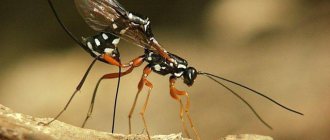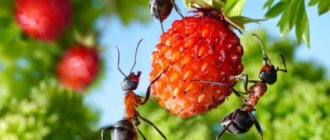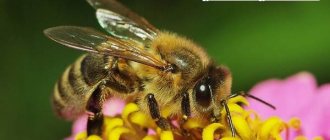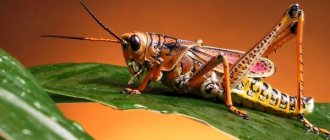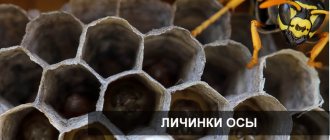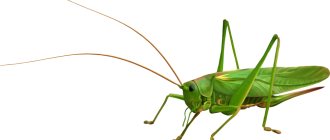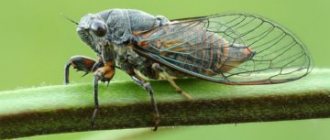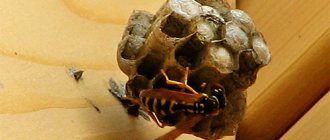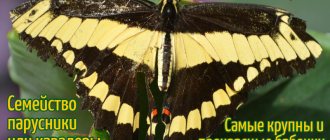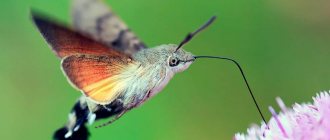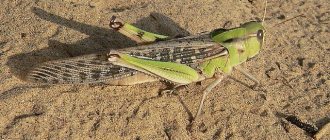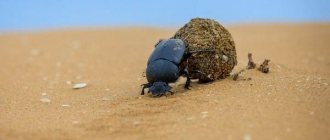- Wild animals
- >>
- Insects
Starting in spring, people try to spend more time in nature, near rivers and reservoirs. Clean air, the sound of water, the sun - all this has a beneficial effect on health, mood and well-being. Another advantage of such a pastime is the opportunity to get to know unique animals better. In particular, this is a water strider , which is also called a water bug. You can learn more about these insects and their lifestyle in this publication.
Origin of the species and description
Photo: Water strider
The water strider is a rather elegant, lightweight insect that lives on the surface of rivers, ponds, and swamps. Very often it is confused with spiders due to its thin and long legs. Sometimes the water bug is mistaken for a cockroach or just a beetle. Water striders are a name that unites a whole family of hemipteran insects. They belong to the suborder of bedbugs. In Latin, the name of such animals sounds like “Gerridae”.
Video: Water strider
Today, it is known that there are more than seven hundred species of water striders that live on the water. This is the most common type of such insects.
The most famous and widespread types include three:
- pond strider. Its distinctive feature is the bright, rich color of its paws;
- large water bugs. They are practically the largest in the family. The body length of such insects can reach seventeen millimeters;
- slow-moving rod-shaped water strider. This animal received its name solely because of its appearance and habits. Outwardly, this bug very much resembles a stick; it lives in Siberia and leads a measured lifestyle.
It is quite easy to recognize representatives of the water strider family. They have average dimensions for insects, large and thin legs. From a distance they can really resemble a spider. Water bugs live on the water surface. Their paws are covered with very hard hairs that have water-repellent properties. This is why a water strider can easily glide through the water and not sink.
All representatives of this family have many common features, one of which is developmental stages. All water striders go through two stages: larvae and adults. In the first stage, water striders live for about a month. At this time, their body is actively developing and changing its color. From a greenish insect with short legs, they gradually turn into a rather large brown bug with long, thin legs, allowing them to move freely along the surface of ponds and reservoirs.
Habitat
Ordinary water striders live in reservoirs, near the shore, so that they can hide from fish in the thickets of plants. Marine individuals inhabit mainly the Pacific and Indian Oceans. Freshwater water striders live on the surface of rivers, lakes with weak currents, as well as in small puddles and streams. They usually choose warm, tropical climates. However, they can survive in harsh, snowy climates.
Appearance and features
Photo: Water strider insect
The water strider is a predatory insect, the dimensions of which depend on the species. Most of the species of these animals have a small body size - only a few millimeters in length. However, many water strider bugs are large in size for an insect. Some species can reach a length of seventeen millimeters. The color of the body also largely depends on the species. It ranges from greenish to dark brown. The lower part of the abdomen and legs of the insect are covered with stiff bristles. It has water-repellent properties. The abdomen is usually brown or gray in color.
Insects have a small head, against which the proboscis and antennae stand out. Antennae are an important part of the water strider's body. They help the animal to detect various odors and serve for the sense of touch. The proboscis takes part in hunting. With its help, the bug injects a special enzyme into its victim. This enzyme dissolves the insides of prey.
Particular attention of people in the appearance of water bugs is always attracted by the legs. They look frighteningly long. Water striders have three pairs of legs, each of which is endowed with its own functional abilities. The first two legs (the shortest) are used during hunting to capture prey, the middle and rear pairs are necessary for support and movement. The bristles located on the legs retain air, which makes the insect “unsinkable”. Some adult species also have wings. With their help, water striders fly over various distances to search for food.
Interesting fact: Lake and river water bugs do not have wings. They simply don't need them. The species of water striders that live in puddles need them most. With the help of their wings, these insects can move, because puddles dry up sooner or later.
Their way of life
A large number of well-known species of water striders live in reservoirs: large, armored, velia, stick, small, etc. The large water strider reaches a length of about 17 mm. She has wings and a reddish body. Pond species about 1 cm long. It has a dark brown color, light legs, and black stripes on the front legs. At the same time, female pond snails have a red abdomen, and males have a black one.
The marine species is 5 mm smaller, but can move at speeds of up to 3.5 km/h. It lives in the Indian and Pacific Oceans and feeds on fish eggs. Insects are found in open water, often several kilometers from land. Scientists also found out where the water strider bug lives. It lives in bodies of water with a lot of vegetation. In this case, most often, water striders choose stagnant water, which has a very weak current. They spend most of their lives on the surface of the water. There are also winged species that, if desired, can move to other bodies of water. Wingless individuals do not change location.
Their life is short and lasts only one year. Parasites are not dangerous to humans. They bite, but these bites are not poisonous, although they are painful. People usually come into contact with them while swimming in bodies of water. The favorite places of insects are human toes and hands.
It is worth knowing what the water strider bug feeds on in the pond. Their usual food is fish fry or insects that have fallen into the pond. Parasites have piercing-sucking mouthparts. Using the trunk, they introduce an enzyme into the body of the fry, which dissolves all organs and tissues, after which it absorbs the resulting mass. However, there are those who like to feed on small bugs, water striders. Among them are herons and frogs. You can easily find a video of a frog happily eating water strider bugs.
How do insects reproduce?
During reproduction, insects lay eggs several times, and according to a certain pattern. The female places them in a single row on the surface of plants growing in water bodies. At the same time, the water strider secretes mucus, with the help of which it attaches the eggs not only to the leaves, but also to each other. From a distance, a clutch of eggs, the number of which can be up to 50, resembles a long light cord.
During laying, a male is constantly near the female. He ensures her safety and peace. Parasites reproduce all summer, and their larvae are similar to adults, only small in size.
During the mating season, males are very jealous of their territory and do not allow other males to approach the female. When an opponent appears, they begin to hit the water surface with their paws. Scientists claim that insects are able to control a large area in order to prevent a meeting with a so-called competitor. The male easily recognizes the sliding of his female through the water, so he will not attack her.
Interesting facts about parasites
There are some interesting facts about water strider bugs. For example, many are interested in the answer to the question of why small water strider bugs do not drown in water. The fact is that the long legs of the insect are covered with tiny hairs. They trap air, so they help him maintain balance. In addition, their abdomen is lubricated with a wax-like liquid. It repels water and prevents the water strider from drowning. It was also noticed that insects located among a large number of air bubbles look silvery. When winter comes, parasites begin to prepare for the winter, which they spend on land. During this time, the muscles that control the wings atrophy. This is the answer to why water strider bugs become wingless during the cold season.
Some time ago, scientists established another feature of these insects. It turned out that they affect the reduction of the horsefly population. The fact is that horseflies lay their eggs in bodies of water where their larvae develop. Water striders feed on both fly larvae and adults. Moreover, an adult horsefly is too large for one insect, so it is usually attacked by several bugs at once. It was found that one bug will suck a horsefly for about an hour, while a flock will take only a few minutes.
The respiratory organs of parasites are presented in the form of tubes. The respiratory system is located in the front of the abdomen, but insects cannot breathe under water. To capture air, they have to surface.
Why do you dream about parasites?
Sometimes questions arise not only regarding who eats the water strider bug, but also why they dream. There are several authoritative dream books that can help solve the dream. These insects are very unpleasant, so many people believe that a dream with their participation warns of various troubles. Dream Interpretations agree with this opinion.
For example, Miller’s dream book claims that bedbugs in a dream are a harbinger of a long illness and other misfortunes. If there were a lot of them, it means that in reality some event will radically change your destiny. Seeing dead insects means misfortune that will arise due to some disease. Squashing parasites that produce water instead of blood indicates an accident that will happen soon. Bugs crawling on a white wall mean a disease with a quick cure. According to the Small Velesov Dream Book, parasites dream of trouble, boredom, annoying people who force you to communicate with yourself from time to time, but do not cause much interest. The source also claims that parasites can predict material well-being, but most likely it will appear only after serious and long work, which was accompanied by great hassle. But this prediction is only valid if you simply watch the crawling insects. If you have to look for them, it means that soon you will have unpleasant troubles and significant expenses. According to the publication, an eaten bug could mean a scandal or quarrel in the near future.
A similar interpretation is given by the dream book of Simon Kananit, who claims that bedbugs foretell a meeting with an annoying, unpleasant acquaintance. Allegedly, this person will drain positive energy from you the same way bedbugs drink blood. The dream book of birthday people for January-April agrees with this prediction. He says that parasites indicate the presence of an energy vampire near you
The love dream book claims that seeing bedbugs means impending troubles with your loved one. It is possible that he will lie to you a lot and show his two-faced nature. A large number of parasites is a harbinger of betrayal or an impartial act on the part of a partner.
Return to description
Where does the water strider live?
Photo: Pond strider
Water striders are a huge family of about seven hundred species. Therefore, their natural habitat is quite extensive. These insects are found almost everywhere where there are stagnant bodies of water, ponds and even puddles. The only exceptions are very cold regions with harsh winters. The water strider lives in Poland, Sweden, Finland, Russia, Ukraine, Belarus, America and many other countries.
The water strider puts forward a number of requirements for its habitat. They need a temperate climate with warm winters and water - a pond, reservoir or river with a slow flow. Some types of such insects live in puddles. Such water striders have wings so that if the puddle dries out, they can move to another place. The legs of water bugs are long, but very comfortable. This allows the animal to move quickly not only through water, but also on land.
There are species of water bugs that can survive in huge salty bodies of water. For example, these are sea water striders. They differ from their relatives in their tiny dimensions. Another important requirement for a place of residence is the presence of vegetation near a water source. Insects spend the winter in it, hibernating. Sometimes they overwinter in coastal soil. Water striders wake up only with the onset of warm weather.
Now you know where the insect lives. Let's see what water striders eat.
Are water bugs dangerous for humans?
All varieties of water bugs do not pose a danger to humans. They do not attack people themselves, but they can bite if threatened. When they bite, they inject a certain amount of poison, but it can only cause an allergic reaction in the form of redness. Tropical bedbugs bite harder, their venom is more irritating, but these bites are not dangerous. Bedbug bites can be compared to bee or wasp stings. The irritated area calms down after about a week.
In addition, bedbugs simply do not bite humans. Most often, their victims are children and overly curious adults who decide to touch the insect. The bug bites a person only for defensive purposes.
But people pose a certain danger to bedbugs. In Southeast Asia they are used as food. For example, belostoma is considered a delicacy. These insects are even specially bred on farms. In some places, belostomas have been almost completely destroyed in their natural habitat. Catching these bugs is easy - just lure them to a source of bright light. Catching whitefish for food has led to the fact that these predators have become very scarce.
What does a water strider eat?
Photo: Water strider bug
Water striders are excellent hunters. They have acute vision and developed motion receptors. Movement receptors are located on the antennae and limbs, which allows insects to quickly respond to any fluctuations in the water. They react almost instantly to movement in the water, so they easily get food for themselves. These small water bugs are true predators. Their daily diet consists of a huge number of insects, fish, beetles and other small representatives of the animal world.
The front pair of legs takes an active part in catching prey. It is equipped with special hooks. Their water bugs are used to firmly capture prey. The proboscis also plays an important role in the feeding process. Its water strider pierces its prey to suck out nutrients or inject venom. The proboscis is long, but it does not interfere with movement. After eating, the animal tucks it under its chest.
Water striders' favorite treats are:
- flies, horsefly mosquitoes. These insects become food for bedbugs only through their own carelessness. Sometimes they fly too close to the water or accidentally fall into it;
- eggs of small insects, fish roe. The water strider finds such food on swampy shores;
- jellyfish, fish fry, physalia. Such food is the main one in the diet of sea water striders;
- remains of deceased fauna representatives. The water strider is a unique and very useful creature. Representatives of this family eat a large number of remains, cleaning water bodies and banks.
Interesting fact: Water striders often have conflicts and even fights among themselves over food. Insects often steal food from each other using their tenacious front legs.
Ability to run on waves
The water strider is an insect whose description always boils down to a story about its amazing ability to withstand the water element. So how does she manage not to drown? The thing is that the bedbug's legs are covered with a special substance that resembles fat in its structure. This creates a kind of barrier that prevents the limbs from submerging in the water.
In addition, the insect knows how to correctly distribute weight: the load does not fall on one point, but is evenly transferred to all six limbs. As for the high speed of movement, it is achieved through fast, impulse strokes. It is they who create turbulence behind the water strider, which pushes it forward.
It is noteworthy that the bug can swim both on mirror-smooth surfaces and among waves. It is this skill that allows water striders to settle in various types of reservoirs, which significantly increases their survival rate, and, consequently, the population.
Features of character and lifestyle
Photo: Water strider beetle
Water striders are the name of a whole group of small insects, which perfectly conveys their lifestyle. These animals measure the surface of the water with their thin and long legs. It is water that is an integral part of the habitat of such insects. Water striders move through water with ease and do not drown thanks to special bristles on their belly and legs. During the day, they can glide along the water surface for hours, hunting for small insects, fry, flies and even mosquitoes.
In catching prey, animals use everything that nature has given them: acute vision, tenacious paws, a sharp piercing proboscis, and movement receptors. Being an inhabitant of ponds and reservoirs, water bugs are always in sight. However, even here nature helped them, giving them an inconspicuous dark brown color. This color and slender body make them almost invisible to enemies.
Many species of water striders have wings. However, such insects fly extremely rarely. Only some species really need wings to survive. We are talking about those insects that live in small puddles. Any puddle dries out over time, so bedbugs have to look for a new one. They fly to another puddle using their wings. The rest of the time the wings are not used.
In summer, water striders spend most of the day on the water, in winter - in dense thickets or soil. In winter, these animals hibernate. In the warm season, the population of water striders in reservoirs, swamps, rivers and ponds is quite high. While relaxing in nature, probably every person has observed such an insect in close proximity. Bedbugs rarely come to land - only when necessary. This is due to the fact that their paws are poorly adapted for moving on the ground.
Social structure and reproduction
Photo: Great water strider
After hibernation, water striders are ready for the breeding process. For them, this process occurs almost immediately with the onset of heat and in the middle of summer. For this reason, in one summer season on reservoirs you can see similar insects of completely different ages. To mate, the male chooses a female and mounts her right in the water. Within a week after mating, the female can lay eggs.
Interesting fact: Water striders are very prolific insects. At one time, a female water bug can lay up to fifty eggs. This allows most species to maintain their high population in nature despite the impact of many negative factors.
The female bug lays eggs on the leaves of various plants that are in the water. The masonry has a rather unusual appearance - it is a long jelly-like cord. All the eggs are neatly laid out in it. Small species of water striders lay eggs without mucus. They stack them in piles or stick them into the leaves of plants.
After a couple of weeks, larvae hatch from the eggs. They develop very quickly and within a month they completely turn into adults. However, young animals are always different from their parents. Young water striders are small in size and have a slightly swollen belly. The lifespan of these animals is short - only one year. However, this does not prevent the family from being one of the most numerous insects in the world and stably maintaining its population.
Natural enemies of water striders
Photo: Water strider
The water strider spends most of its life on the water, rarely appearing on land. That is why all its natural enemies live in ponds and reservoirs. However, there are not many of them. These animals mainly feed on fish and some frogs, tree frogs, and toads. They deftly hunt water bugs. The worst enemy of water striders is the water mite. The larvae of such ticks cause enormous harm to the animal. They bite through the body of the water strider and drink its blood.
The water strider is not an easy prey for predators. These creatures are quite neat and agile. They are good jumpers and can move at high speed. Sensing danger, many water bugs manage to quickly leave the area. They have well-developed motion receptors, so even the slightest splash of water will alert them.
Interesting fact: Few people know about the benefits that water bugs bring to the ecosystem. They are often called orderlies of reservoirs, swamps and rivers. These animals are able to purify water from blood-sucking horse flies. They are “regulators” of the population of these pests.
Humans cannot be called a natural enemy of water striders. People do not deliberately destroy these insects, because they bring great benefits. Water bugs, in addition to being useful, are absolutely safe for people. This insect can bite only in exceptional cases when it is in real danger from a person.
Population and species status
Photo: Water strider on the water
Water striders are one of the largest families of insects. It includes more than seven hundred species of animals, so their overall population is not a cause for concern. Water bugs have been given the conservation status of Least Concern. This status indicates that this insect family is not in danger of extinction in the very near future.
Various factors have a positive effect on the high population of water striders:
- benefits for the ecosystem and humans. People do not try to get rid of water striders, because they know that they are the orderlies of the reservoir. This animal brings great benefits by controlling the population of blood-sucking horse flies;
- high natural fertility. Water striders breed several times a year. At one time, the female lays about fifty eggs, from which larvae then hatch;
- high survival rate. Water bugs have a short lifespan - only one year. However, before this time, adults rarely die. These are neat, fast and dexterous insects. They rarely become victims of natural enemies and practically do not get sick.
Despite the overall rosy picture, some species of the water strider family are included in the Red Books of individual states and cities. For example, we are talking about a sphagnum water strider. This animal is a rare species.
